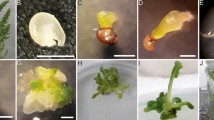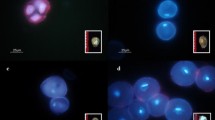Abstract
To induce development of isolated carrot ovules, flowers were pollinated with pollen from different species. Effects of pollen origin, medium composition, and light conditions were evaluated for 13 carrot cultivars. The highest efficiency of development was recorded following pollination of carrot flowers with parsley pollen. The highest frequency of embryo formation (0.84%) was obtained for cv. ‘Flamanka’; whereas the highest frequency of callus formation (1.56%) was obtained for cv. ‘Karlena’. Medium supplemented with indole-3-acetic acid (IAA) promoted embryo development (0.63%), while supplementation with 2,4-dichlorophenoxyacetic acid (2,4-D) and 6-benzyladenine (BA) promoted callus development (1.34%). Placement of isolated ovules in the dark stimulated embryo development. Embryos and calli thus obtained were regenerated into plants. Flow cytometry revealed that 97.7% regenerants were diploid. Based on a phosphoglucoisomerase (PGI) isozyme assay, 45.9% diploid regenerants were homozygous. Pollen tube growth of parsley, parsnip, celery, and cabbage in carrot pistils were studied using the aniline blue fluorescent method. The pollen tube growth was inhibited in transmitting tissues of the pistils.






Similar content being viewed by others
Abbreviations
- BA:
-
6-Benzyladenine
- B5:
-
Gamborg’s basal salt and vitamins
- 2,4-D:
-
2,4-Dichlorophenoxyacetic acid
- DAPI:
-
4,6-Diamidino-2-phenylindole
- IAA:
-
Indole-3-acetic acid
- MS:
-
Murashige and Skoog basal salt and vitamins
- NAA:
-
α-Naphthaleneacetic acid
- PVP:
-
Polyvinylpyrrolidone
- PGI:
-
Phosphoglucoisomerase
- PGR’s:
-
Plant growth regulators
- Tris:
-
2-Amino-2-hydroxymethyl-1,3-propanediol
References
Adamus A, Michalik B (2003) Anther cultures of carrot (Daucus carota L.). Folia Hort 15:49–58
Andersen SB, Christiansen I, Farestveit B (1990) Carrot (Daucus carota L.): In vitro production of haploids and field trials. In: Bajaj YPS (ed) Biotechnology in agriculture and forestry, vol 12. Haploids in crop improvement I. Springer, Berlin, pp 393–402
Barański R (2000) Application of rapid glucose-6-phosphate isomerase assay in white cabbage breeding. Acta Physiol Plant 22:45–51
Bartosova Z, Obert B, Takac T, Kormutak A, Pretova A (2005) Using enzyme polymorphism to identify the gametic origin of flax regenerants. Acta Biol Crac 47:173–178
Bohanec B, Jakše M (1999) Variations in gynogenic response among long-day onion (Allium cepa L.) accessions. Plant Cell Rep 18:737–742
Bohanec B, Jakše M, Ihan A, Javornik B (1995) Studies of gynogenesis in onion (Allium cepa L.): induction procedures and genetic analysis of regenerants. Plant Sci 104:215–224
Borthwick HA, Phillips M, Robbins WW (1931) Floral development in Daucus carota. Am J Bot 18:784–796
Compton ME (1994) Statistical methods suitable for the analysis of plant tissue culture data. Plant Cell Tissue Organ Cult 37:217–242
Dohya N, Matsubara S, Murakami K (1997) Callus formation and regeneration of adventitious embryos from celery microspores by anther and isolated microspore cultures. J Jan Soc Hort Sci 65:747–752
Doré C, Boulidard L (1988) Production de plantes androgenetiques de chou a choucroute (Brassica oleracea L. ssp. capitata) par culture d’antheres in vitro: comportement des lignees haploids doubles (HD) et leur interet comme parents d’hybrides F1. Agronomie 8:851–862
Doré C, Boulidard L, Sauton A, Rode J-C, Cuny F, Niemirowicz-Szczytt K, Sari N, Dumas de Vaulx R (1995) Interest of irradiated pollen for obtaining haploid vegetables. Acta Hort 392:123–128
Eenink AH (1974) Matromorphy in Brassica oleracea L. II. Differences in parthenogenetic ability and parthenogenesis inducing ability. Euphytica 23:435–445
Faris NM, Rakoczy-Trojanowska M, Malepszy S, Niemirowicz-Szczytt K (2000) Diploidization of cucumber (Cucumis sativus L.) haploids by in vitro culture of leaf explant. In: Bielecki S, Tramper J, Polak J (eds) Food biotechnology. Elsevier, Amsterdam, pp 49–54
Forster BP, Heberle-Bors E, Kasha KJ, Touraev A (2007) The resurgence of haploids in higher plants. Trends Plant Sci 12:368–375
Gamborg OL, Miller RA, Ojima O (1968) Nutrient requirements of suspension cultures of soybean root cell. Exp Cell Res 50:151–158
Germanà MA, Chiancone B (2001) Gynogenetic haploids of Citrus after in vitro pollination with triploid pollen grains. Plant Cell Tissue Organ Cult 66:59–66
Górecka K, Krzyżanowska D (2001) The use of androgenesis in vitro to obtain homozygous lines of vegetable plants. Veg Crops Res Bullet 54:7–11
Górecka K, Krzyżanowska D, Kiszczak W, Skierki J (2003) Ploidy level of androgenic carrot plants. X-th In Vitro Culture and Plant Biotechnology Conference, Bydgoszcz, Poland, 15–17 Sept, p 75
Górecka K, Krzyżanowska D, Górecki R (2005) The influence of several factors on the efficiency of androgenesis in carrot. J Appl Genet 46:265–269
Höfer M, Grafe Ch, Boudichajevskaja A, Lopez A, Bueno MA, Roen D (2008) Characterization of plant material obtained by in vitro androgenesis and in situ parthenogenesis in apple. Sci Hort 117:203–211
Hu KL, Matsubara S, Murakami K (1993) Haploid plant production by anther culture in carrot. J Jan Soc Hort Sci 62:561–565
Jensen CJ (1986) Haploid induction and production in crop plants. In: Horn W, Jensen CJ, Odenbach W, Schreder O (eds) Genetic manipulation in plant breeding. Proceedings of Eucarpia. Walter de Gruvter, Berlin, pp 231–256
Kantartzi SK, Demetrios G, Roupakias G (2009) In vitro gynogenesis in cotton (Gossypium sp.). Plant Cell Tissue Organ Cult 96:53–57
Kho YO, Baër J (1968) Observing pollen tubes by means of fluorescence. Euphytica 17:298–302
Lallemand L, Briand F (1995) Use of electrophoresis for variety testing in carrot. Plant Breed 114:372–374
Lim W, Earle E (2008) Effect of in vitro and in vivo colchicines treatments on pollen production and fruit set of melon plants obtained by pollination with irradiated pollen. Plant Cell Tissue Organ Cult 95:115–124
Lux H, Herrman L, Wetzel C (1990) Production of haploid sugar beet (Beta vulgaris L.) by culturing unpollinated ovules. Plant Breed 104:177–183
Manickam S, Sarkar KR (1999) Foreign pollen tube growth in maize after chemical treatments. Indian J Genet Plant Breed 59:53–58
Matsubara S, Dohya N, Murakami K (1995) Callus formation and regeneration of adventitious embryos from carrot, fennel and mitsuba microspores by anther and isolated microspore cultures. Acta Hort 392:129–137
Monakhova MA, Tyukavin GB, Shmykova NA (1998) Change of ploidy during formation regenerated plants from androgenous and gynogenous embryos of carrot in vitro. In: Proceedings of the IX international congress on plant tissue and cell culture, plant biotechnology and in vitro biology in the 21st century, Jerusalem, Israel, p 122
Muranty H, Sourdille P, Bernard S, Bernard M (2002) Genetic characterization of spontaneous diploid androgenetic wheat and triticale plants. Plant Breed 121:470–474
Murashige T, Skoog F (1962) A revised medium for rapid growth and bio assays with tobacco tissue cultures. Physiol Plant 15:473–497
Murgineux A, Barloy D, Leroy P, Beckert M (1993) Molecular and morphological evaluation of doubled haploid lines in maize. 1. Homogenity within DH lines. Theor Appl Genet 86:837–842
Peloquin SJ, Hougas R, Gabert AC (1965) Haploidy as a new approach to the cytogenetics and breeding of Solanum tuberosum. Heredity 20:21–28
Prem D, Gupta K, Sarkar G, Agnihotri A (2008) Activated charcoal induced high frequency microspore embryogenesis and efficient doubled haploid production in Brassica juncea. Plant Cell Tissue Organ Cult 93:269–282
Puddephat IJ, Robinson HT, Smith B, Lynn J (1999) Influence of stock plant pre-treatment on gynonic embryo induction from flower buds of onion. Plant Cell Tissue Organ Cult 57:145–148
Reger BJ, James J (1982) Pollen germination and pollen tube growth of sorghum when crossed to maize and pearl millet. Crop Sci 22:140–144
Rode JC, Dumas de Vaulx R (1987) Obtention des plantes haploides de carotte (Daucus carota L.) issues de parthénogenése induite in situ par du pollen irradié et culture in vitro des graines immatures. CR Acad Sci Paris 305:225–229
Sato S, Katoh N, Yoshida S, Iwai S, Hagimori M (2000) Production of doubled haploid plants of carnation (Dianthus caryophyllus L.) by pseudofertilized ovule culture. Sci Hort 83:301–310
Shmykova NA, Tyukavin GB (2002) Characteristics of morphological and genetic changes during in vitro culturing of carrot anthers. Biotechnology (Биoтexнoлoгия) 5:65–69
Simon PW (2000) Domestication, historicial, development, and modern breeding of carrot. Plant Breed Rev 19:157–190
St Pierre MD, Bayer RJ, Weis IM (1990) An isozyme-based assessment of the genetic variability within the Daucus carota complex (Apiaceae: Caucalideae). Can J Bot 68:2449–2457
Stein M, Nothnagel T (1995) Some remarks on carrot breeding (Daucus carota sativus Hoffm.). Plant Breed 114:1–11
Uváčková L, Múdry P, Obert B, Preťová A (2008) Enzyme fingerprint analyses in tissue regenerated from anther culture of maize. Acta Physiol Plant doi: 10.1007/s11738-008-0180-4
Westphal L, Wricke G (1991) Genetic and linkage analysis of isozyme loci in Daucus carota L. Euphytica 56:259–267
Zhao ZY, Gu MG (1984) Production of diploid pure lines of maize through parthenogenesis induced by chemicals. Acta Genet Sinica 11:39–46
Zhou SQ, Qian DQ, Cao XY (1991) Induction of parthenogenesis and chromosome behaviour in plants of parthenogenetic origin of cotton (Gossypium hirsutum). Genome 34(2):255–260
Acknowledgments
We thank Prof Zygmunt Kaczmarek for his advice on the statistical analysis, Dorota Chachlowska for her assistance with tissue cultures, and Krystyna Strycharczuk for the ploidy analysis of the regenerants. We also thank Dr Rafał Barański and Dr Dariusz Grzebelus for their comments on the manuscript.
Author information
Authors and Affiliations
Corresponding author
Rights and permissions
About this article
Cite this article
Kiełkowska, A., Adamus, A. In vitro culture of unfertilized ovules in carrot (Daucus carota L.). Plant Cell Tiss Organ Cult 102, 309–319 (2010). https://doi.org/10.1007/s11240-010-9735-3
Received:
Accepted:
Published:
Issue Date:
DOI: https://doi.org/10.1007/s11240-010-9735-3




